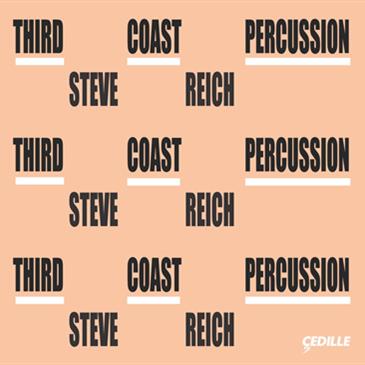by Jeremy Reynolds

I agree. Buy it. Listen to it — it runs just over an hour. Relax into Reich’s mesmerizing mallet music, his hypnotic harmonic hierarchies. Rather than adding my voice to the many rave reviews of the disc, let’s talk about psychoacoustics instead.
Psychoacoustics is a branch of psychology concerned with the physiological effects of sound. In the case of music, this involves finding scientific reasons for why certain melodies, harmonies, rhythms, etc. make us feel the way we do. It’s a relatively new field; research took a leap in the 1950s with the advent of electronic music, which allowed composers — including Reich — to exercise more precise control over the sounds that listeners experienced.
In order, the album features the Mallet Quartet (two marimbas and two vibraphones), the Sextet (four percussionist playing a variety of instruments plus two keyboardists), Nagoya Marimbas (two marimbas), and Music for Pieces of Wood (pieces of wood — Reich is also creative with his titles). All of the pieces follow the composer’s trademark, pulsing harmonic architecture.
The Mallet Quartet begins and ends with a sprightly rhythmic ostinato. The music is repetitive, but captivatingly so. A common psychoacoustic effect of listening to Reich’s music is that it’s easy to fall into a meditative or trance-like state through the simple repetitions and pulses. A section begins and seems to stretch ad infinitum before the music shifts and our internal clock restarts. It’s a relaxing, even trippy aspect of listening to minimalist composers like Reich or Philip Glass. What is particularly impressive about Third Coast Percussion’s interpretation is that in spite of the repetition, the ensemble still draws the ear to certain lines — little moments that stand out and give the piece shape. These tiny events anchor the ear, striking a pleasant balance between that trance-like state and active listening.
The Sextet is a large-form palindrome. The five moments follow a ABCBA pattern in tempo (Fast, Moderate, Slow, Moderate, Fast). Hypnosis is also strong in this work, with a luxurious contrast between percussive pulses and bowed vibraphone bars, creating longer, sustained tones, and the swells play with listeners’ perceptions of near and far. When the music crescendos, it feels as though it is approaching and vice versa — sans Doppler Effect of course.
The movements flow directly into one another, but the shifts are fairly obvious as they involve dramatic mood changes. From the sinister, generally low-pitched opening number, the piece moves to a reflective, moody second movement before shifting to an aggressively slow tempo in the middle of the piece, with sharp, percussive jabs punctuating lighter, more ethereal passages. The fourth and fifth movements slowly lighten the timbre until the Sextet finishes with a bright, jubilant flourish in the higher registers of the pitched instruments. It’s quite euphoric. Beginning low and ending high gives the sense of climbing, the higher pitches resonating brilliantly thanks to their overtone series. It’s pleasantly triumphant, and deceptively simple, as is so much of Reich’s music.
Both Nagoya Marimbas and Music for Pieces of Wood are homogenous in timbre, yet the ensemble still manages to keep different voices distinct. Rather than create a wash of repeated sound, they give the music a more conversational, responsive feel. That makes listening to the space between notes just as exciting as the different patterns of notes themselves. It’s an alternative way of listening to minimalist music, but equally profitable, and it’s impossible to not be delighted by Third Coast Percussion’s dexterity and charisma. Psychoacoustic jargon aside — seriously, go buy this album. It’s is available on the ensemble’s website, on iTunes, and from other retailers.
Published on ClevelandClassical.com October 23, 2016.
Click here for a printable copy of this article



